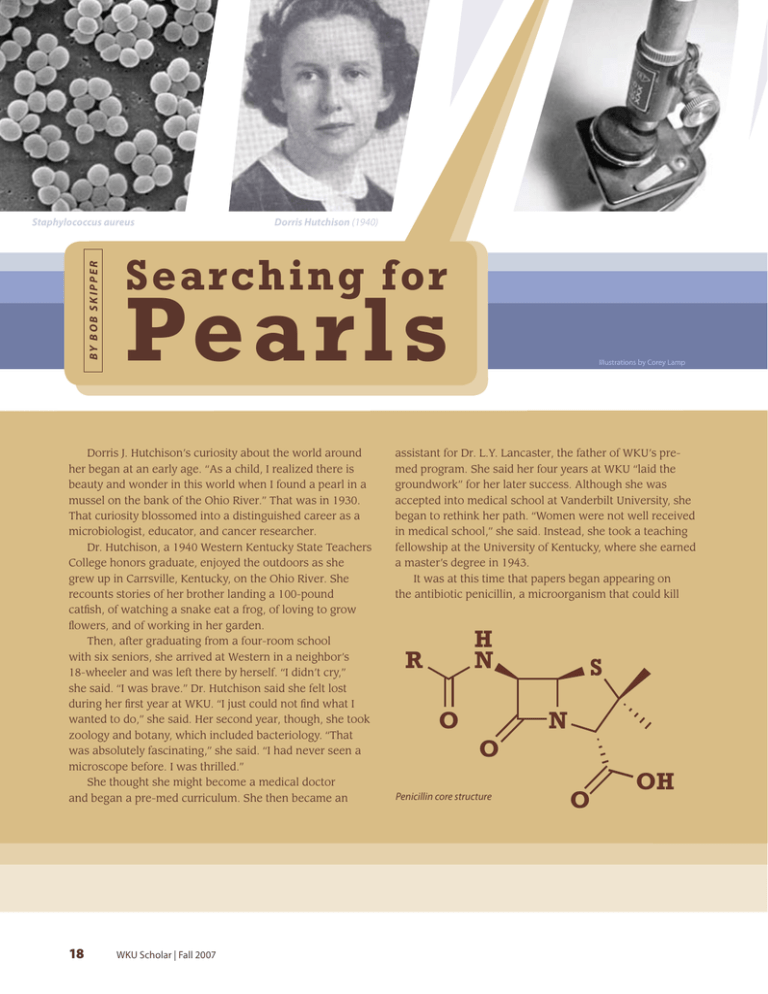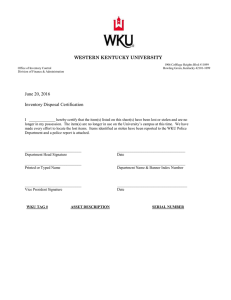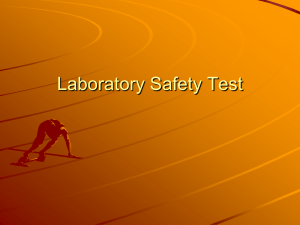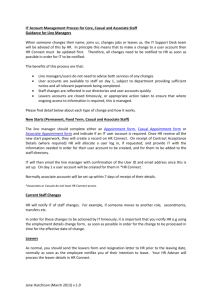Pearls Searching for
advertisement

BY BOB SKIPPER Staphylococcus aureus Dorris Hutchison (1940) Searching for Pearls Dorris J. Hutchison’s curiosity about the world around her began at an early age. “As a child, I realized there is beauty and wonder in this world when I found a pearl in a mussel on the bank of the Ohio River.” That was in 1930. That curiosity blossomed into a distinguished career as a microbiologist, educator, and cancer researcher. Dr. Hutchison, a 1940 Western Kentucky State Teachers College honors graduate, enjoyed the outdoors as she grew up in Carrsville, Kentucky, on the Ohio River. She recounts stories of her brother landing a 100-pound catfish, of watching a snake eat a frog, of loving to grow flowers, and of working in her garden. Then, after graduating from a four-room school with six seniors, she arrived at Western in a neighbor’s 18-wheeler and was left there by herself. “I didn’t cry,” she said. “I was brave.” Dr. Hutchison said she felt lost during her first year at WKU. “I just could not find what I wanted to do,” she said. Her second year, though, she took zoology and botany, which included bacteriology. “That was absolutely fascinating,” she said. “I had never seen a microscope before. I was thrilled.” She thought she might become a medical doctor and began a pre-med curriculum. She then became an 18 WKU Scholar | Fall 2007 Illustrations by Corey Lamp assistant for Dr. L.Y. Lancaster, the father of WKU’s premed program. She said her four years at WKU “laid the groundwork” for her later success. Although she was accepted into medical school at Vanderbilt University, she began to rethink her path. “Women were not well received in medical school,” she said. Instead, she took a teaching fellowship at the University of Kentucky, where she earned a master’s degree in 1943. It was at this time that papers began appearing on the antibiotic penicillin, a microorganism that could kill H N R O O Penicillin core structure S N O OH Dr. Selman A. Waksman Dr. Dorris Hutchison WKU Hall of Distinguished Alumni inductee, 2003 “ I was looking for how we can use what we have in a more effective way, I was still looking for pearls. “ other microorganisms. This influenced her thesis, which dealt with the search for other antagonistic organisms in well water in Fayette County, Kentucky, and led to her first publication. Dr. Hutchison began teaching microbiology at Russell Sage College in New York. While at Sage, she met Dr. Selman A. Waksman, a pioneer in the discovery of new antibiotics, during a talk at the New York State Health Department. “I wanted to go to work for him because he was on the forefront of antibiotic research,” Dr. Hutchison said. Dr. Waksman helped her land a new position teaching at Vassar College. While at Vassar, Dr. Hutchison kept in contact with Dr. Waksman. As men returned from military service at the end of World War II, opportunities for women to advance became fewer, she said, so she joined Dr. Waksman by taking a research fellowship at Rutgers University. It was there that she earned her doctorate in 1949. Dr. Waksman, his students, and associates isolated a number of new antibiotics, such as actinomycin, streptomycin, and neomycin. Streptomycin and neomycin proved useful in the treatment of many infectious diseases, including tuberculosis. The patent on streptomycin has been listed as one of the ten patents that shaped the world. Dr. Hutchison was the only female among a group of thirteen students engaged in the research. Some strains of tuberculosis, however, proved resistant to streptomycin, and Dr. Hutchison began looking for other antibiotics to treat those strains. She said her work led to the isolation of “the best rat poison in the world” because the antibiotics were lethal. “The key was to find a dose high enough to cure the disease without killing the patient,” she explained. She said she spent hours testing antibiotics against streptomycin-resistant tuberculosis and had to be under constant medical monitoring because of the exposure. And because the work required the use of a Bunsen burner, she often stripped down while working in the lab “and the guys in the lab would try to peek through the blinds,” she said, laughing. Dr. Hutchison’s claim to fame at Rutgers came in 1949 with the development of neomycin, which is still used as a primary antibiotic. Dr. Waksman received the Nobel Western Kentucky University 19 Acute Leukemia HO O HO O H2N NH 2 NH 2 HO NH 2 O O O O OH NH 2 HO OH OH NH 2 Neomycin Prize in Physiology or Medicine in 1952 for his work in antibiotics and Dr. Hutchison said she “got the glory for the tuberculosis work.” In 1951, Dr. Hutchison joined Sloan-Kettering Institute for Cancer Research, where she continued until her retirement in 1991. Her research centered on agents effective against leukemia, especially strains that had become resistant to other drugs. “I was looking for how we can use what we have in a more effective way,” she said. “I was still looking for pearls.” She said her personal major contribution was the development of a cancer treatment using methotrexate with Citrovorum Factor (CF) rescue. A patient is given a sufficiently high dose that is lethal, which is countered with a vitamin at the appropriate time. “The timing was worked out in my lab,” Dr. Hutchison said. “You basically kill the subject and rescue it.” She said this is one of the accomplishments of which she is most proud. During her research career, she wrote more than 130 publications dealing with chemotherapy, “ The timing was worked out in my lab. You basically kill the subject and rescue it. “ treatment of tuberculosis and leukemia, and other cancerrelated topics. She is included in Who’s Who in the World, American Men and Women of Science, Who’s Who in America, and Who’s Who of American Women. Other honors include the Dr. Dorris J. Hutchison Graduate Fellowship at the Cornell University Graduate School of Medical Science; WKU Hall of Distinguished Alumni; Bronze Medal Award from the American Cancer Society, Westchester Division; and Philippe Foundation Fellowship. Her hometown of Carrsville named its community center for her and Cornell named a student lounge for her. In addition to her research, Dr. Hutchison was an active volunteer. She served on numerous boards and committees, including as president of the New York Society of Kentucky Women. She also established the Dorris J. Hutchison Scholarship at WKU for women interested in the sciences. And while she said her academic career, including positions at Cornell and Wellesley College, was not world shattering, it was “very satisfying.” n Dr. Hutchison died May 9, 2007, shortly after she was interviewed by WKU Scholar. She was eighty-eight years old. 20 WKU Scholar | Fall 2007




